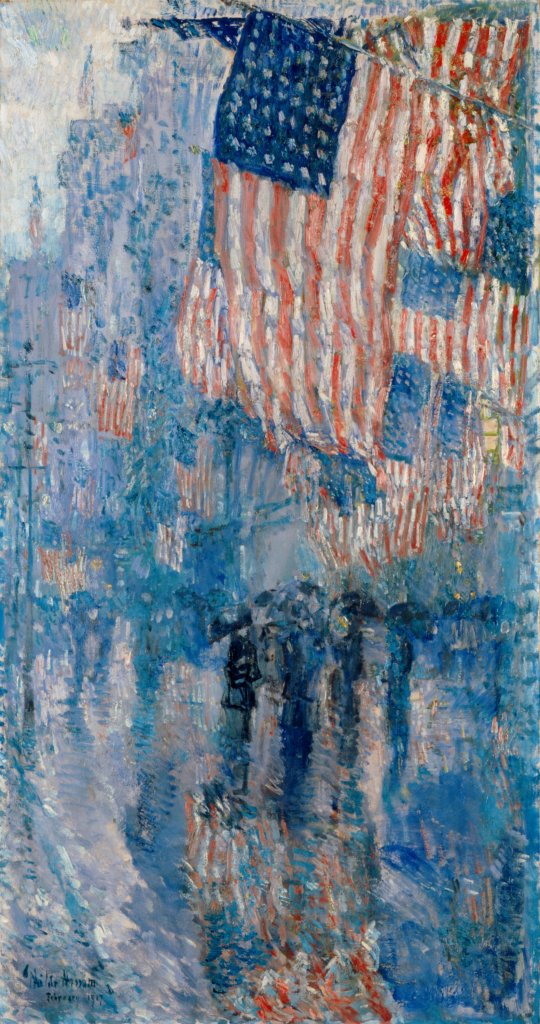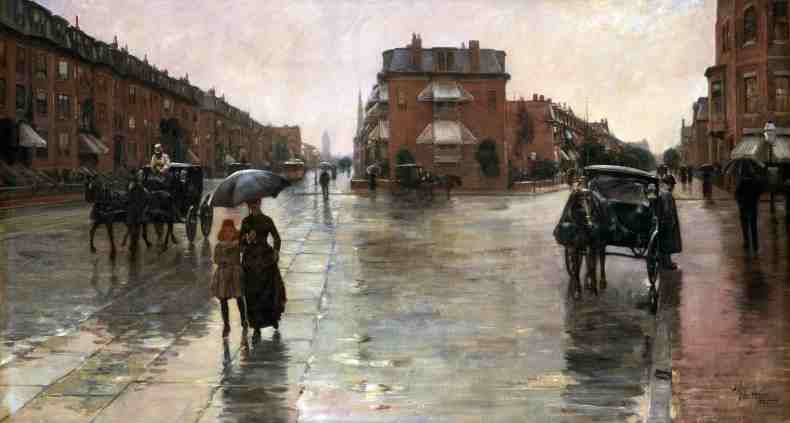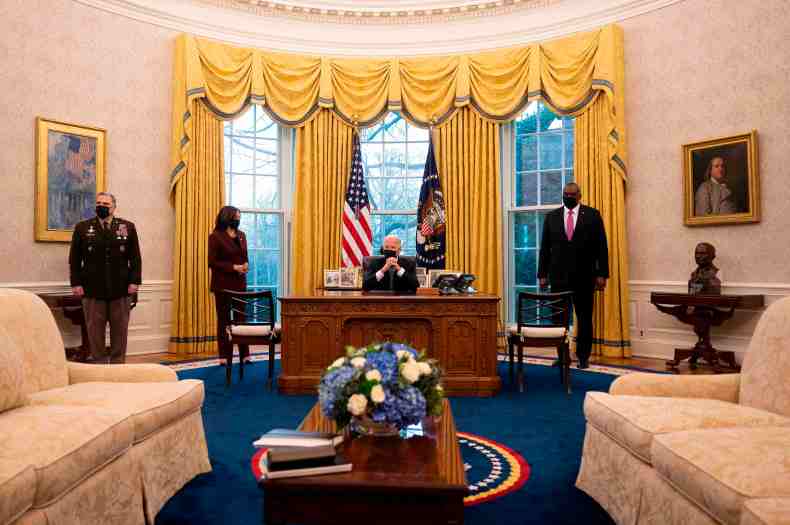Every four or eight years, with the redecoration of the Oval Office, art historians have a chance to address matters of national consequence. This time round, in keeping with the melodrama of past weeks, the changes are particularly symbolic. Away with a portrait of Andrew Jackson – who owned hundreds of slaves, and prosecuted wars of brutal aggression against Native Americans – and in with busts of Rosa Parks and César Chávez. These swaps were as clear a repudiation of the previous administration as the executive orders Biden signed on his first day at the Resolute desk.

The Avenue in the Rain (1917), Childe Hassam. White House, Washington, D.C.
In comparison, the reintroduction of another painting, Avenue in the Rain (1917) by Childe Hassam, seems fairly innocuous. It was hung by Clinton and Obama, and Trump had it up too, for a while. Given its subject matter – a welter of American flags, rendered in an unusually vertical composition that is itself flag-like – it seems an obvious enough choice.
Not much sport for the commentator, then? Not so fast. For, whether Biden was aware of it or not, he could not have chosen a more suitable work to emblematise his administration in its first days. To begin with, it’s not just any city street Hassam shows. The picture shows Fifth Avenue in Manhattan, which is of course where Trump Tower stands today. In 1917, just prior to America’s entry into the Great War, this was a common setting for parades, a symbol of unity both domestic and international. It would even briefly be rechristened the Avenue of the Allies in 1918. Hassam painted at least 30 canvases showing the flag-bedecked thoroughfare, even showing them 22 at a time, to correspond to the number of Allied countries in the conflict.
As this bit of corny jingoism suggests, Hassam was far from a fire-breathing radical. He adopted the new ideas of Impressionism when they were still fresh, in the 1880s, and more or less kept pace with them over succeeding decades. The umbrella-carrying figures in the White House painting recall pictures like Rainy Day, Boston (1885, Toledo Museum of Art), which itself transposed the Parisian scenes of Gustave Caillebotte to American soil. Hassam’s flag series was one of several applications of Monet’s idea to paint the same subject again and again under different conditions. Squint at Avenue in the Rain, and you almost feel you can glimpse Rouen Cathedral in the background.

Rainy Day, Boston (1885), Childe Hassam. Toledo Museum of Art
Yet Hassam, a born follower, allowed his Impressionism to congeal into formula. When a large number of his paintings are shown together – as they were in the Metropolitan Museum of Art’s survey of his work in 2004 – the effect is just the opposite of Monet. They fairly stun, not due to exhilarating pictorial invention, but bland repetition.

Hunt the flag: Joe Biden’s Oval Office. Jim Watson/AFP via Getty Image
Think how very different it would have been, had Biden hung a Jasper Johns flag painting instead of Hassam’s. (Alas, there isn’t one in the collection, though Johns was reportedly on the Obamas’ long list for potential acquisition.) The blunt, beguiling facticity of Johns’ flags – they seem to withhold their true meanings, sphinx-like, even after all these years – could not be more different from the accessible, sentimental patriotism of Hassam’s picture.
But you know what? A cityscape lashed by the elements, flags looking somewhat bedraggled – one shown in reflection on the wet ground – it feels just about right, right now. Biden is the man for the moment, the perfect president for a traumatised and exhausted body politic, and Hassam’s aesthetics of reassurance are equally welcome. He has left us a pictorial equivalent to that other Star-Spangled Banner – our national anthem – giving proof to the night that the flag is still there.

There’s a soggy Stars and Stripes in the Oval Office – and it’s a perfect emblem for the task ahead
Standard stuff? The Avenue in the Rain (1917; detail), Childe Hassam
Share
Every four or eight years, with the redecoration of the Oval Office, art historians have a chance to address matters of national consequence. This time round, in keeping with the melodrama of past weeks, the changes are particularly symbolic. Away with a portrait of Andrew Jackson – who owned hundreds of slaves, and prosecuted wars of brutal aggression against Native Americans – and in with busts of Rosa Parks and César Chávez. These swaps were as clear a repudiation of the previous administration as the executive orders Biden signed on his first day at the Resolute desk.
The Avenue in the Rain (1917), Childe Hassam. White House, Washington, D.C.
In comparison, the reintroduction of another painting, Avenue in the Rain (1917) by Childe Hassam, seems fairly innocuous. It was hung by Clinton and Obama, and Trump had it up too, for a while. Given its subject matter – a welter of American flags, rendered in an unusually vertical composition that is itself flag-like – it seems an obvious enough choice.
Not much sport for the commentator, then? Not so fast. For, whether Biden was aware of it or not, he could not have chosen a more suitable work to emblematise his administration in its first days. To begin with, it’s not just any city street Hassam shows. The picture shows Fifth Avenue in Manhattan, which is of course where Trump Tower stands today. In 1917, just prior to America’s entry into the Great War, this was a common setting for parades, a symbol of unity both domestic and international. It would even briefly be rechristened the Avenue of the Allies in 1918. Hassam painted at least 30 canvases showing the flag-bedecked thoroughfare, even showing them 22 at a time, to correspond to the number of Allied countries in the conflict.
As this bit of corny jingoism suggests, Hassam was far from a fire-breathing radical. He adopted the new ideas of Impressionism when they were still fresh, in the 1880s, and more or less kept pace with them over succeeding decades. The umbrella-carrying figures in the White House painting recall pictures like Rainy Day, Boston (1885, Toledo Museum of Art), which itself transposed the Parisian scenes of Gustave Caillebotte to American soil. Hassam’s flag series was one of several applications of Monet’s idea to paint the same subject again and again under different conditions. Squint at Avenue in the Rain, and you almost feel you can glimpse Rouen Cathedral in the background.
Rainy Day, Boston (1885), Childe Hassam. Toledo Museum of Art
Yet Hassam, a born follower, allowed his Impressionism to congeal into formula. When a large number of his paintings are shown together – as they were in the Metropolitan Museum of Art’s survey of his work in 2004 – the effect is just the opposite of Monet. They fairly stun, not due to exhilarating pictorial invention, but bland repetition.
Hunt the flag: Joe Biden’s Oval Office. Jim Watson/AFP via Getty Image
Think how very different it would have been, had Biden hung a Jasper Johns flag painting instead of Hassam’s. (Alas, there isn’t one in the collection, though Johns was reportedly on the Obamas’ long list for potential acquisition.) The blunt, beguiling facticity of Johns’ flags – they seem to withhold their true meanings, sphinx-like, even after all these years – could not be more different from the accessible, sentimental patriotism of Hassam’s picture.
But you know what? A cityscape lashed by the elements, flags looking somewhat bedraggled – one shown in reflection on the wet ground – it feels just about right, right now. Biden is the man for the moment, the perfect president for a traumatised and exhausted body politic, and Hassam’s aesthetics of reassurance are equally welcome. He has left us a pictorial equivalent to that other Star-Spangled Banner – our national anthem – giving proof to the night that the flag is still there.
Unlimited access from just $16 every 3 months
Subscribe to get unlimited and exclusive access to the top art stories, interviews and exhibition reviews.
Share
Recommended for you
The art world put its weight behind Biden. Will he repay the favour?
The new administration is better disposed to the arts, but that doesn’t mean there’ll be more federal funding
The invasion of the Capitol fulfilled a warning from history – and will haunt us for years to come
The inauguration of Joe Biden as president marks a new chapter, but it won’t wipe out the ugly scenes of the storming of Congress
The art world is smitten with Bernie Sanders’ mittens
A meme of Bernie at the inauguration has (predictably) seen the senator popping up in everyone’s favourite paintings